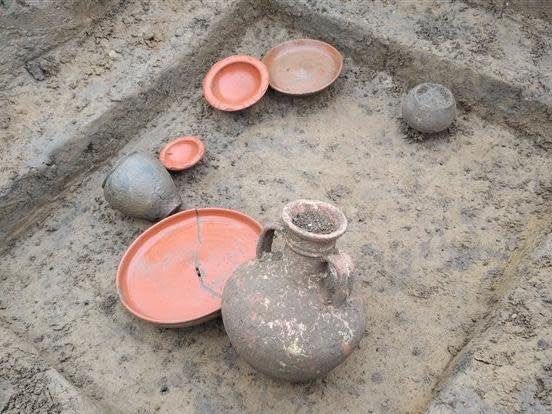Remains of entire Roman town discovered next to motorway in Kent
Archaeologists have hailed the discovery of an entire Roman town and main road as “massive” for their understanding of ancient Kentish development.
An 18-acre settlement containing rare coins, pottery and jewellery dating back as early as 43 AD has been uncovered next to a major motorway in Newington.
Evidence of a 7m-wide road was also found, alongside the remains of an ancient temple, close to the A2 – which itself tracks an ancient link with Canterbury and the coast.
Experts have said the discovery is one of the most significant finds made in the region.
Dean Coles, chair of the Newington History Group, said: “This is very exciting. The scale of this site, with the huge number and quality of finds, changes our knowledge of Newington’s development.”
He added: “We already had evidence of a Roman burial ground and Roman occupation in the immediate vicinity and this excavation shows there was a thriving manufacturing site in the heart of our village.
“The temple and major road are massive discoveries. It proves the A2 wasn’t the only Roman road through the village.
“As a group, we are keen to trace the route and destination of this new ‘highway’ which may have connected with another temple excavated 50 years ago on the outskirts of Newington and a villa unearthed in 1882.”

The buried town was found during the development of 124 new homes.
Once they have analysed their findings and published a report, experts will cover up the ancient remains so the new housing can be completed.
Dr Paul Wilkinson, archaeological director at Swale and Thames Archaeological Survey, said: “This is one of the most important discoveries of a Roman small town in Kent for many years with the preservation of Roman buildings and artefacts exceptional.”
Romans invaded Britain in 43 AD and remained for almost 400 years.
Remains of their occupation have been found scattered across the UK, including Hadrian’s Wall in Northumberland and the Roman Baths in Bath.
The discovery comes after an “incredibly rare” Roman-era coin was found in Cambridgeshire, minted during the two-month reign of a breakaway emperor in the 3rd century.
And the chance find of a Celtic shield in a field in Leicestershire has changed experts’ understanding of how ancient Britons fought in wars.

 Yahoo News
Yahoo News 
